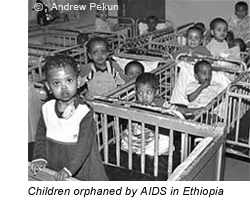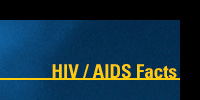|
The AIDS Pandemic
Current Worldwide Statistics
- 4.9 million people were newly infected with HIV in 2004. 4.3 million of these are adults, 2.0 million women, and 640,000 children under age 15.
- At the end of 2004 there were 39.4 million people living with HIV/AIDS, 37.2 million adults, 17.6 million women and 2.2 million children under age 15.
- In 2004 there were 3.1 million deaths due to HIV/AIDS. 2.6 million were adults & 510,000 children under age 15.
- An estimate 20 million people have died since the beginning of the epidemic.
- Women are becoming increasingly affected by HIV. Approximately 47% or 17.6 million of 37.2 million adults living with HIV or AIDS worldwide are women.
- More than 95% of all HIV-infected people live in the developing world, which has likewise experienced 95% of all deaths from AIDS.
- Of 39.4 million infected individuals worldwide, 25.4 million reside in sub-Saharan Africa.
Current Statistics in the United States
- Estimates suggest that 950,000 Americans were living with HIV at the end of 2003, with approximately 32,000 new infections occurring each year.
- Of those living with HIV/AIDS, 36% are white, 42% black, 20% Hispanic and 2% others.
- Of those living with HIV/AIDS, 77% are men, of which causes of infection were
- 58% from having sex with men
- 22% from injection drug use
- 8% from having sex with men combined with injection drug use and
- 11% from heterosexual sex.
- Of women living with HIV/AIDS, causes of infection were
- 63% from heterosexual contact and
- 35% from injection drug use.African AIDS Pandemic
African AIDS Pandemic
Sub-Saharan Africa is the region of the world that is most affected by HIV & AIDS. An estimated 25.4 million people are living with HIV and approximately 3.1 million new infections occurred in 2004. In just the past year the epidemic has claimed the lives of an estimated 2.3 million people in this region. Around 2 million children under 15 are living with HIV and more than twelve million children have been orphaned by AIDS.
The extent of the epidemic is only now becoming clear in many African countries, as increasing numbers of people with HIV are now becoming ill. In the absence of massively expanded prevention, treatment and care efforts, the AIDS death toll on the continent is expected to continue rising before peaking around the end of the decade. This means that the worst of the epidemic's impact on these societies will be felt in the course of the next ten years and beyond. Its social and economic consequences are already being felt widely not only in health but in education, industry, agriculture, transport, human resources and the economy in general.
HIV & AIDS have a widespread impact on many parts of society.
 In many countries of Sub-Saharan Africa, AIDS is erasing decades of progress made in extending life expectancy. Millions of adults are dying young or in early middle age. Average life expectancy in Sub-Saharan Africa is now 47 years, when it could have been 62 without AIDS. In many countries of Sub-Saharan Africa, AIDS is erasing decades of progress made in extending life expectancy. Millions of adults are dying young or in early middle age. Average life expectancy in Sub-Saharan Africa is now 47 years, when it could have been 62 without AIDS.
- The toll of HIV/AIDS on households can be very severe. Many families are losing their income earners and the families of those that die have to find money to pay for their funerals. Many of those dying have surviving partners who are themselves infected and in need of care. They leave behind children grieving and struggling to survive without a parent's care. HIV/AIDS strips the family assets further impoverishing the poor. In many cases, the presence of AIDS means that the household eventually dissolves, as the parents die and children are sent to relatives for care and upbringing.
- In all affected countries, the HIV/AIDS epidemic is bringing additional pressure to bear on the health sector. As the epidemic matures, the demand for care for those living with HIV rises, as does the toll among health workers. Health-care services face different levels of strain, depending on the number of people who seek services, the nature of their need, and the capacity to deliver that care.
- How schools and other educational institutions are able to cope is a major factor in how well societies will eventually recover from the HIV/AIDS epidemic. A decline in school enrolment is one of the most visible effects of the HIV/AIDS epidemic on education in Africa.
- HIV/AIDS dramatically affects labor, setting back economic activity and social progress. The vast majority of people living with HIV/AIDS in Africa are between the ages of 15 and 49 - in the prime of their working lives. Employers, schools, factories and hospitals have to train other staff to replace those at the workplace who become too ill to work.
The latest statistics on the world epidemic of AIDS & HIV were published by UNAIDS/WHO in December 2004. The report gives the latest AIDS and HIV statistics for the whole world and for regions. The information above was taken directly from the UNAIDS/WHO website. Additional data for 2004 can be accessed at http://www.unaids.org/wad2004/report.html.
Home | Los Altos Rotary AIDS Project | The Los Altos Story | Child AIDS Prevention | HIV/AIDS Book Distribution | Programs | What’s New | AIDS Facts | How You Can Help | Contact Us
© 2009. Los Altos Rotary Club. All rights reserved.
|



